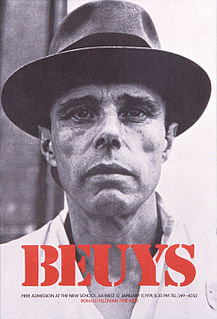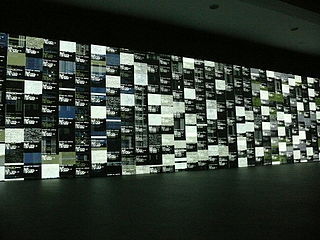Related Research Articles

Fluxus was an international, interdisciplinary community of artists, composers, designers and poets during the 1960s and 1970s who engaged in experimental art performances which emphasized the artistic process over the finished product. Fluxus is known for experimental contributions to different artistic media and disciplines and for generating new art forms. These art forms include intermedia, a term coined by Fluxus artist Dick Higgins; conceptual art, first developed by Henry Flynt, an artist contentiously associated with Fluxus; and video art, first pioneered by Nam June Paik and Wolf Vostell. Dutch gallerist and art critic Harry Ruhé describes Fluxus as "the most radical and experimental art movement of the sixties".

The term artistamp or artist's stamp refers to a postage stamp-like art form used to depict or commemorate any subject its creator chooses. Artistamps are a form of Cinderella stamps in that they are not valid for postage, but they differ from forgeries or bogus Illegal stamps in that typically the creator has no intent to defraud postal authorities or stamp collectors.

Joseph Heinrich Beuys was a German artist, teacher, performance artist, and art theorist whose work reflected concepts of humanism, sociology, and anthroposophy. He was a founder of a provocative art movement known as Fluxus and was a key figure in the development of Happenings.

Postmodern art is a body of art movements that sought to contradict some aspects of modernism or some aspects that emerged or developed in its aftermath. In general, movements such as intermedia, installation art, conceptual art and multimedia, particularly involving video are described as postmodern.

Ruud Janssen is a Dutch Fluxus and mail artist currently living in Breda in the Netherlands.

Mail art, also known as postal art and correspondence art, is an artistic movement centered on sending small-scale works through the postal service. It initially developed out of what eventually became Ray Johnson's New York Correspondence School and the Fluxus movements of the 1960s, though it has since developed into a global movement that continues to the present.

Dick Higgins (1938–1998) was an American artist, composer, art theorist, poet, publisher, printmaker, and a co-founder of the Fluxus international artistic movement. Inspired by John Cage, Higgins was an early pioneer of electronic correspondence. Higgins coined the word intermedia to describe his artistic activities, defining it in a 1965 essay by the same name, published in the first number of the Something Else Newsletter. His most notable audio contributions include Danger Music scores and the Intermedia concept to describe the ineffable inter-disciplinary activities that became prevalent in the 1960s.
Ken Friedman, was a member of Fluxus, an international laboratory for experimental art, architecture, design, and music. Friedman joined Fluxus in 1966 as the youngest member of the classic Fluxus group. He has worked closely with other Fluxus artists and composers such as George Maciunas, Dick Higgins, and Nam June Paik, as well as collaborating with John Cage and Joseph Beuys. He was the general manager of Dick Higgins's Something Else Press in the early 1970s. In the 1990s, Friedman's work as a management consultant and designer led him to an academic career, first as Professor of Leadership and Strategic Design at the Norwegian School of Management in Oslo, then as Dean of the Faculty of Design at Swinburne University of Technology in Melbourne. Friedman is currently University Distinguished Professor at Swinburne and Chair Professor of Design Innovation Studies at Tongji University.

Yasunao Tone is a multi-disciplinary artist born in Tokyo, Japan and working in New York City. He graduated from Chiba University in 1957 with a major in Japanese Literature. An important figure in postwar Japanese art during the sixties, he was active in many facets of the Tokyo art scene. He was a central member of Group Ongaku and was associated with a number of other Japanese art groups such as Neo-Dada Organizers, Hi-Red Center, and Team Random. Tone was also a member of Fluxus and one of the founding members of its Japanese branch. Many of his works were performed at Fluxus festivals or distributed by George Maciunas’s Flux Press. Relocating to the United States in 1972, he has since gained a reputation as a musician, performer and writer working with the Merce Cunningham Dance Company, Senda Nengudi, Florian Hecker, and many others. Tone is also known as a pioneer of “Glitch” music due to his groundbreaking modifications of compact discs and CD players.

George Brecht, born George Ellis MacDiarmid, was an American conceptual artist and avant-garde composer, as well as a professional chemist who worked as a consultant for companies including Pfizer, Johnson & Johnson, and Mobil Oil. He was a key member of, and influence on, Fluxus, the international group of avant-garde artists centred on George Maciunas, having been involved with the group from the first performances in Wiesbaden 1962 until Maciunas' death in 1978.
Geoffrey Hendricks was an American artist associated with Fluxus since the mid 1960s. He was professor emeritus of art at Rutgers University, where he taught from 1956 to 2003 and was associated with Allan Kaprow, Roy Lichtenstein, and Lucas Samaras during the 1960s.

Water Yam is an artist's book by the American artist George Brecht. Originally published in Germany, June 1963 in a box designed by George Maciunas and typeset by Tomas Schmit, it has been re-published in various countries several times since. It is now considered one of the most influential artworks released by Fluxus, the internationalist avant-garde art movement active predominantly in the 1960s and '70s. The box, sometimes referred to as a Fluxbox or Fluxkit, contains a large number of small printed cards, containing instructions known as event-scores, or fluxscores. Typically open-ended, these scores, whether performed in public, private or left to the imagination, leave a lot of space for chance and indeterminancy, forcing a large degree of interpretation upon the performers and audience.
In some cases [event-scores] would arise out of the creation of the object, while in others the object was discovered and Brecht subsequently wrote a score for it, thus highlighting the relationship between language and perception. Or, in the words of the artist, "ensuring that the details of everyday life, the random constellations of objects that surround us, stop going unnoticed." The event-score was as much a critique of conventional artistic representation as it was a gesture of firm resistance against individual alienation.

Joe Jones was an American avant-garde musician associated with Fluxus especially known for his creation of rhythmic music machines.

Robert Watts (1923-1988) was an American artist best known for his work as a member of the international group of artists Fluxus. Born in Burlington, Iowa June 14, 1923, he became Professor of Art at Douglass College, Rutgers University, New Jersey in 1953, a post he kept until 1984. In the 1950s, he was in close contact with other teachers at Rutgers including Allan Kaprow, Geoffrey Hendricks and Roy Lichtenstein. This has led some critics to claim that pop art and conceptual art began at Rutgers.

Milan Knížák is a Czech performance artist, sculptor, musician, installation artist, dissident, graphic artist, art theorist and pedagogue of art.

John Held Jr. , is an American mailartist, author and performance artist who has been an active participant in alternative art since 1975, particularly in the fields of rubber stamp art, zine culture, and artistamps. He is one of the most prominent and respected promoters and chroniclers of mail art.
Mieko Shiomi is a Japanese artist, composer, and performer who played a key role in the development of Fluxus. A co-founder of the seminal postwar Japanese experimental music collective Group Ongaku, she is known for her investigations of the nature and limits of sound, music, and auditory experiences. Her work has been widely circulated as Fluxus editions, featured in concert halls, museums, galleries, and non-traditional spaces, and re-performed by other musicians and artists numerous times. She is best known for her work of the 1960s and early 1970s, especially Spatial Poem, Water Music, Endless Box, and the various instructions in Events & Games, all of which were produced as Fluxus editions. Now in her eighties, she continues to produce new work.

Anna Banana is a Canadian artist known for her performance art, writing, and work as a small press publisher. She has been described as an "entrepreneur and critic", and pioneered the artistamp, a postage-stamp-sized medium. She has been prominent in the mail art movement since the early 1970s, acting as a bridge between the movement's early history and its second generation. As a publisher, Banana launched Vile magazine and the "Banana Rag" newsletter; the latter became Artistamp News in 1996.
Giovanni Fontana is an Italian poet, performance artist, author and publisher.
Joel S. Cohen is an American graphic artist and cofounder, along with Diane E. Milder, of Ragged Edge Press, an independent offset printing company in New York City. Principally recognized for his creative mail art projects and artistic collaborations with Thomas Kerr and Kurt Vonnegut, Cohen has been creating, printing, and distributing progressive political art since the early 1970s.
References
- ↑ The Fake Picabia Bros., Gaglione, Picasso, and Held, Jr., John, Stamp Art Editions, San Francisco. 1995. 58 Pages. (Available from the Stamp Art Gallery, 466 8th Street, San Francisco, CA 94103)
- ↑ Mail-Interview Projects, Janssen, Ruud, editor, Eight Volumes. TAM Archive, P.O. Box 1055, 4801 BB Breda, Netherlands. September 1995.) Online Version
- ↑ Andrzej Dudek-Dürer Biography (in Polish)
- ↑ Interview with Lucien Suel (in French)